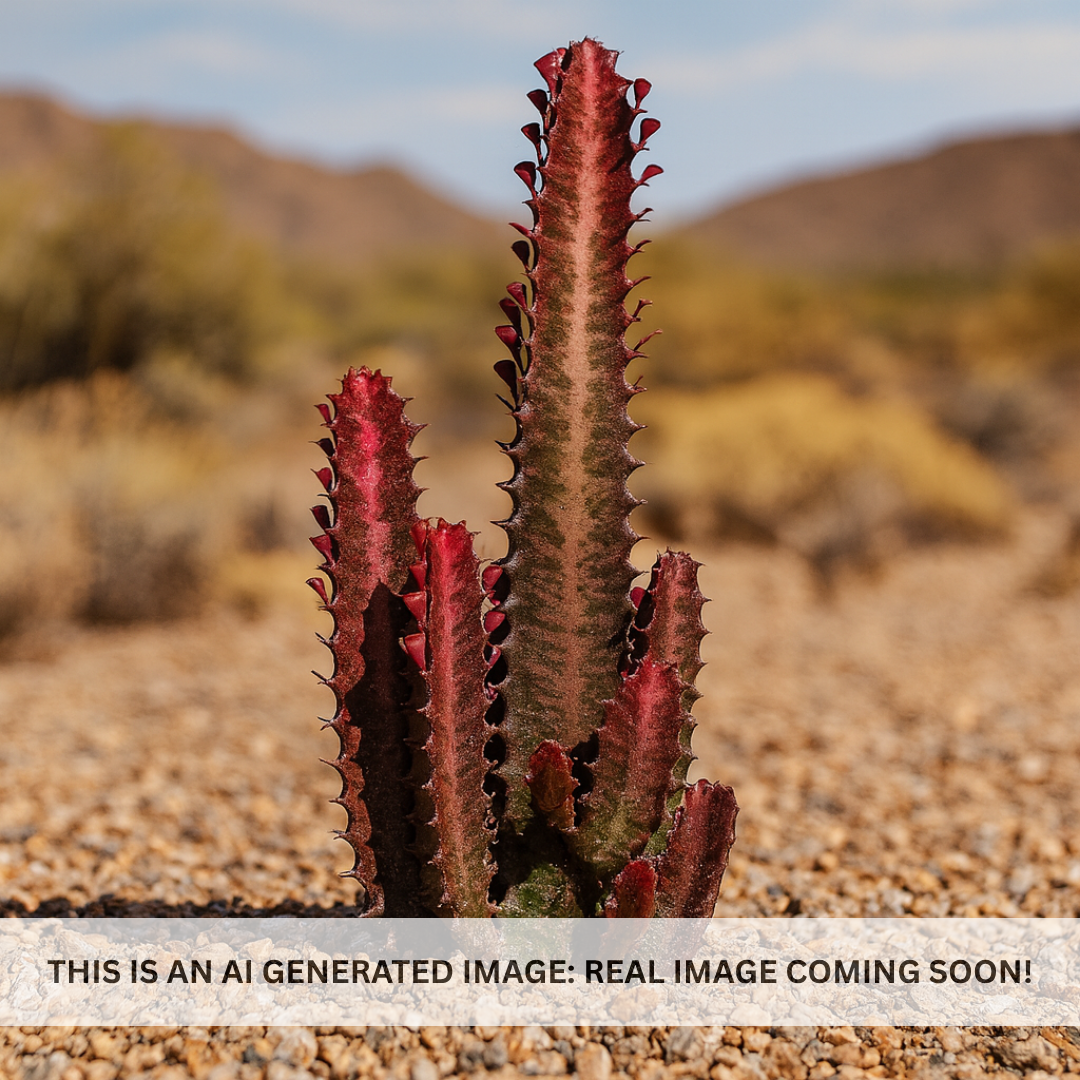My Store
Ruby Red
Ruby Red
Couldn't load pickup availability
Plant Type: perennial, succulent shrub
Plant Height: 4–9 feet (can reach up to 12 feet with age)
Spread: 2–4 feet
Flower Color: inconspicuous yellow-green
Sun Exposure: Full sun, Partial Shade
Ruby Red / Euphorbia trigona ‘Red’: A Striking, Sculptural Succulent with Deep Burgundy Coloration
Euphorbia trigona ‘Red’, commonly known as Ruby Red African Milk Tree, is a stunning, upright succulent prized for its vibrant red-to-burgundy stems and bold, geometric structure. A colorful cultivar of Euphorbia trigona, this plant offers all the drought tolerance and resilience of its green counterpart while adding a dramatic pop of color that intensifies in bright desert light. Native to Central Africa, Ruby Red thrives in the intense sun and arid conditions of Arizona, making it a perfect choice for homeowners seeking architectural beauty with vivid color and minimal water requirements.
Key Features of Euphorbia trigona ‘Red’
This euphorbia forms tall, triangular stems with three to four prominent ridges lined by small, paired spines and teardrop-shaped leaves. Unlike the standard green form, Ruby Red exhibits stunning coloration that ranges from rose-red to deep maroon, often accented by green undertones along the ribs. The color deepens in full sun and cooler temperatures, giving it a dynamic, ever-changing appearance. The plant’s upright growth habit and branching nature create a candelabra-like silhouette, making it one of the most eye-catching succulents for architectural or modern desert landscapes. While its flowers are small and not ornamental, the vivid stems more than make up for it with their year-round visual appeal.
Growing and Care Tips
Euphorbia trigona ‘Red’ thrives in full sun, where its richest red hues are achieved. It can tolerate partial shade, but color intensity may fade if sunlight is limited. In the Phoenix Valley, full morning and midday sun with light afternoon protection during the hottest months helps preserve both color and leaf health. Use a fast-draining cactus or succulent mix blended with sand or pumice. Overwatering should be avoided—this euphorbia prefers dry conditions and can quickly decline in soggy soil. It is frost-sensitive and should be protected or covered when temperatures drop below 35°F. If grown in a container, ensure the pot is heavy enough to support its tall, columnar form. When handling, use gloves and eye protection, as its milky sap can irritate skin or eyes.
Landscaping Uses
Ruby Red Euphorbia is a true showstopper in any landscape, providing both vertical height and intense color contrast. It’s perfect for modern, minimalist, or xeriscape designs that emphasize bold forms and textures. It pairs beautifully with silver or blue-toned plants like Whale’s Tongue Agave, Blue Elf Aloe, or Silver Torch Cactus, as well as with golden accents like Barrel Cactus. In decorative containers, it adds a sculptural, high-end look to patios and entryways. When planted in groups, the repeating red columns create dramatic rhythm and contrast within rock gardens or architectural plantings.
Summary
Euphorbia trigona ‘Red’ is one of the most striking and low-maintenance succulents available for Arizona landscapes. With its upright, symmetrical structure and deep red coloration, it adds elegance and intensity to any setting. Combining heat tolerance, drought resistance, and year-round vibrancy, the Ruby Red African Milk Tree is a living sculpture that thrives under the desert sun.
Three Timbers Installation Guide (Feel Free to Follow):
Euphorbia trigona ‘Red’ Planting Guide:
Location: Full sun to partial shade; for best color, provide at least 6 hours of direct sunlight daily. Light afternoon shade can help protect new growth during Arizona’s peak summer heat.
Soil: Use a sharply draining cactus or succulent mix blended with sand, gravel, or pumice. Avoid compact or moisture-retaining soils.
Spacing: Allow 3–4 feet between plants to accommodate mature branching and ensure airflow.
Planting Depth: Keep the root crown level with the soil surface; avoid burying the base to prevent moisture accumulation.
Support: Not required; strong vertical stems maintain structure naturally, but large potted specimens may need staking until roots are established.
Watering Guide:
Watering After Planting: Water deeply once after planting to settle the soil, then allow it to dry completely before watering again. During establishment (first 2–3 months), water every 14–20 days depending on heat and soil drainage.
When is the Plant Established? Euphorbia trigona ‘Red’ is considered established after 6–8 months, once new branching and deeper red coloration appear.
Watering Once Established: Water every 4–6 weeks during hot, dry periods. In winter, watering is rarely needed. Avoid frequent watering or standing moisture.
Drip Irrigation Setup: Install one low-flow emitter (0.5–1 gallon per hour) about 8–10 inches from the base of the plant. Run infrequently, allowing the soil to dry completely between irrigation cycles.
General Watering Tips: Always confirm the top several inches of soil are completely dry before watering again. Overwatering can lead to stem collapse or root rot. Use decorative gravel or decomposed granite mulch to retain light surface moisture and enhance color contrast, keeping the material several inches away from the base for airflow and long-term health.
Share














